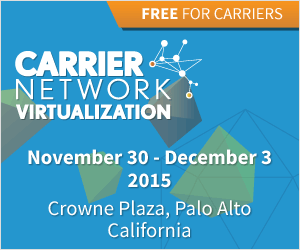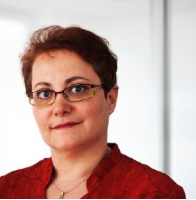The 3rd annual Carrier Network Virtualization event will once again unite the carrier community in California, the heartland of SDN and NFV solutions. The show will be packed with case studies discussing Carrier Class SDN from a unique carrier led perspective. [Read more…]
LTE Africa 2015: Accelerating the Growth of Africa’s 4G LTE Future
2015 has been an exciting year for Africa, with LTE 4G services now provided in 24 African countries, and many more operators expected to launch commercial 4G LTE services by the end of the year. As LTE subscriptions in Africa continue to grow, and with 50% of the region’s population expected to be covered by LTE networks by 2018, LTE Africa 2015 (17-19 November) will return at a time when it has never been more crucial for operators to ensure they have the best plans for the future strategic deployment of LTE networks. [Read more…]
LTE Africa 2015: Receive a Free Pass or 20% Discount from OSS News Review
OSS News Review is delighted to be able to offer you one of our discounted guest passes for the forthcoming LTE Africa 2015 event, taking place on November 17-19 at the Cape Town Convention Centre. [Read more…]
Centina Systems Launches vSure™ to Operationalize NFV and SDN
Centina Systems, the innovation leader in service assurance solutions, announced the launch of their vSure™ product, aimed at helping service providers to successfully transition and operationalize their networks and services from legacy environments to virtual environments. vSure™ complements orchestration by providing closed-loop feedback through a suite of tools and analytics to enable the providers to manage and visualize NFV and SDN environments from end-to-end and top-to-bottom. [Read more…]
Virtualization Needs Strong Use Cases and Ongoing Industry Support to Push Forward
As SDN & OpenFlow World Congress winds down, the future of SDN and NFV will be determined by continued hard work and viable business cases.
This week at SDN & OpenFlow World Congress, a lot of talk was devoted to what’s still needed to get virtualization technologies out of the lab and proof of concept stage and into full-scale commercial productions. This includes multi-vendor support, partnerships, standards and a more open environment. There is movement on each of those fronts, but there’s still a way to go, and in the meantime questions around the business cases and real-world viability of SDN and NFV still swirl around the industry.
Eric Hanselman, Chief Analyst at 451 Research, said that now that the industry has been working with SDN for about seven years and NFV for about three, deployments have finally gone beyond just the theoretical. He said the level of maturity in the technologies and standards, along with a wide range of operators deploying functionality around these capabilities, means SDN and NFV have hit their stride.
However, he cautioned, what’s happening today is part of a much longer journey along which the industry is probably only at the midpoint if even that far. It may still be early days, but Hanselman said the industry must continue to look ahead to areas such as improving scale and capabilities in terms of application sophistication, true service orchestration, a broader ecosystem and greater integration with BSS and OSS.
With interesting use cases such as the Internet of Things (IoT) already here, now’s the time to seize those opportunities to realize the benefits of virtualization.
The Internet of Everything
IoT is a natural use case that will greatly benefit from virtualization technologies. As sensors, wearables and other devices proliferate in applications ranging from connected cars and homes to fitness trackers and package delivery, among just a very few examples, issues such as traffic volume, latency, reliability and performance will be significant. Considering the IoT is expected to quickly ramp up to many billions of devices in the next five years, the network issues alone are daunting.
But by bringing in NFV, operators will be better able to optimize traffic management. For example, by managing bursts of traffic – which will be a common occurrence with many IoT applications – at the network edge, they will be able to manage performance degradation much more efficiently. In addition, operators will be able to offload control and data plane traffic using vEPC, while SDN will bring dynamic provisioning to the table, which will allow for real-time capacity management by allocating bandwidth as needed. SDN will also enable security enforcement at the network edge to provide a more tightly controlled environment for IoT applications.
Commercial Deployments Ramping Up
Another use case for virtualization comes in the form of the virtual CPE (vCPE), which Telefónica plans to roll out in 2016, according to Francisco-Javier Ramon Salguero, Head of Network Virtualization at the operator’s GCTO Unit. He said that while the industry as a whole might be in the middle of the virtualization journey, and not quite to the end goals of better programmability and overall simplicity of network operations, Telefónica belief has been that it’s not enough to discuss the technology; instead, it’s necessary to get your hands dirty in order to move virtualization efforts forward. And with today’s access network getting more and more complicated, vCPE brings a strong business case to operators.
Overall, the mood at SDN & OpenFlow World Congress has been one of optimism but tempered by the reality that the work is far from over. But given the intense commitment on the part of operators, vendors, standards organizations and others, by the next time this event convenes there will likely be many more real-world examples alongside even more interesting and innovative use cases.
*NetCracker Technology submits this article live from the SDN & OpenFlow World Congress
Operators Make Their Virtualization Demands
At SDN & OpenFlow World Congress, it’s the operators in the driver’s seat as they lay out their requirements for advancing virtualization deployments.
With a diverse mix of operators, vendors, standards organizations and others who form the broad ecosystem for virtualization, there are bound to be widely divergent views on what the industry should do, when it should do it and how it should do it. But one thing seems clear: it’s going to be the operators that really drive what happens with SDN and NFV.
Operators are the ones taking the risk, stretching their budgets and expending the energy and resources to move down the virtualization road. And while the benefits of SDN and NFV are crystal clear, the path to realize then doesn’t necessarily follow a straight line.
According to Michael Howard, Senior Research Director, Carrier Networks, at IHS, there are three distinct markets within SDN and NFV: carrier SDN, data center and enterprise SDN and NFV. According to Howard’s research, of a projected total $30 billion combined market in 2019, only $6 billion will be new spend, with the rest constituting existing or displaced numbers.
Specifically, within the SDN space, only 25 percent of spending in 2019 will be new, going toward things like orchestration and controllers, network applications and outsourced services. Only 10 percent of NFV spending will be new, constituting NFV MANO and outsourced services.
So the market is pushing ahead but in unexpected ways. Howard went on to say that there are two primary drivers and two primary barriers to carrier SDN and NFV. He cited drivers as service agility for quicker time to revenue and a global view across multi-domain, multi-vendor networks. For barriers, he mentioned that the software is not yet carrier grade as well as ongoing concerns around how to interoperate both physical and virtual functions in existing networks.
Sticking with the subject of carriers, Howard also said that carriers are clamoring for support of the NETCONF protocol and YANG data modeling language, which he said are on their way as vendors ramp up including them in routers, Carrier Ethernet switches and optical transport products.
The Operators’ Side of the Story
Continuing on the subject of what carriers are doing, Hiroshi Nakamura, Senior Vice President of R&D Strategy at NTT DOCOMO presented an update of his company’s plans for virtualization, saying that he expects to have a commercial vEPC deployment in place by March 2016. This follows on from a proof of concept in early 2014 involving three vendors, and an expanded version later in the year that added three additional vendors to the project.
Nakamura added that standardization is necessary to realize a multi-vendor environment, which is very important to the operator. He said standard interfaces to enable multi-vendor apps and interfaces between existing BSS/OSS will need to be available for large-scale deployments.
He went on to say that in the future, he’d like to see the extension of SDN across data centers in order to get more usage out of resources, especially in the case of natural disasters, something that hit DOCOMO’s home country of Japan extremely hard during the 2011 earthquake. Nakamura said traffic volume on the carrier’s network spiked 60 times above normal, which DOCOMO couldn’t support.
He closed by saying SDN and NFV can be put into practice today, and operators do not need to wait until 5G deployments.
Mirko Voltolini, VP Technology and Architecture at Colt, said that his company started its transformation project in 2009, going from a very siloed approach to one that would support multiple vendors, which seems to be a common theme among operators. Colt’s project, called Novitas, will enable network services to be used, provisioned and orchestrated in real time and on demand with resulting reduced costs, improved time to market and the ability to turn up new services in a more agile manner. This massive project will impact all aspects of Colt’s business but will result in its customers having the ability to self-provision services in near real time or real time with flexible services.
As operators make their demands known, the rest of the industry is taking notice. With major transformation projects already underway at many organizations, it’ll take a lot of cooperation and collaboration to make the shift to a virtualized infrastructure.
*NetCracker Technology submits this article live from the SDN & OpenFlow World Congress
Partnerships, Openness Characterize Next Phases of Virtualization
At SDN & OpenFlow World Congress, operators, vendors and standards organizations come together to take SDN and NFV to the next level.
If there was any commonality among the diverse set of speakers at the plenary session during SDN & OpenFlow World Congress in Dusseldorf, it revolved around the twin themes of open standards and environments and strong partnerships to move virtualization forward at a rapid pace.
Dan Pitt, Executive Director of the Open Networking Foundation (ONF), kicked off the morning sessions by saying that while the SDN value proposition hasn’t changed – making and saving money – the trend is now more on the making money side, especially on the part of enterprises. But operators are also getting into the mix with Open SDN deployments and other projects based on open source.
In fact, Axel Clauberg, VP of Aggregation, Transport, IP & Fixed Access at Deutsche Telekom, said it’s an open world, not a proprietary one, something the operator is taking into consideration as it plans and rolls out an ambitious slate of projects including cloud VPN. Clauberg added that even if SDN and NFV are relatively young technologies, especially compared to the decades-old IP, a lot has happened in just the past few years with the industry going from SDN getting into the spotlight in 2011; the birth of NFV in 2013; proofs of concept in 2013 and 2014; and finally, commercial deployments in 2015.
David Amzallag, Head of Network Virtualization, SDN & NFV, at Vodafone, discussed open interfaces and said that without a clear strategy and effort, SDN and NFV won’t become a reality. He added that Vodafone has an ambitious goal of delivering a single VPN product for all of its operations worldwide, something that will not be possible without a close relationship with vendors and other partners.
Vodafone operates in dozens of countries, making the operator’s transformation to virtualization very challenging as a project of this magnitude touches everything from budget to human resources. Amzallag said his organization is looking toward multi-vendor design and implementation, because bringing in several vendors can only have a positive impact on Vodafone’s network, services and products, and therefore to customers.
Echoing the need for partnerships and cooperation, Noel Foret, VP of Network Control at Orange, said that ecosystem fragmentation is a real risk and to avoid it standardization will need to play a larger role. Orange’s goal is to implement a fully distributed cloud working with SDN, or as Foret put it, a connected cloud, a massive undertaking that will require working with partners to achieve the plug-and-play environment he’s looking for.
Open to the Future
With a veritable alphabet soup of open source organizations present this week, it can be challenging to determine which group is focused on what, who’s involved in each effort and which are considered more standard than others. What seems clear is that vendors and operators alike see value in open source and the benefits of being involved in a larger effort alongside partners and competitors.
No one entity can go it alone in the complex world of virtualization. It will take the combined efforts of operators, vendors, standards organizations and other partners to make that next major push toward taking SDN and NFV to the next level in large-scale production deployments.
*NetCracker Technology submits this article live from the SDN & OpenFlow World Congress
Moving Toward SDN and NFV Operationalization
A major theme during SDN & OpenFlow World Congress this week will be how to get virtualization out of the demo and proof of concept stage and into full-scale production deployments.
From Clean Slate SDN at Stanford University in 2007 to SDN & OpenFlow World Congress in 2015, the software-defined networking and network functions virtualization (NFV) effort has come a very long way. Virtualization began life as a way to rethink the Internet by starting from scratch, hence the Clean Slate nomenclature. After 8 years, the movement has grown into no less than a total overhaul of the entire communications network in what’s considered the biggest disruption to the industry in at least a decade.
At this point, the debate on the merits of SDN and NFV are largely over. Operators and their suppliers understand the benefits of virtualization and are ready to start realizing lower costs, improved agility and flexibility and the ability to offer services quickly, efficiently and tear them down in the same manner.
The next step in the SDN/NFV conversation is how to go from where the industry is today – which largely consists of demos and proofs of concepts – to full operationalization of commercial deployments. This migration will not be an easy one, but is absolutely critical for virtualization uptake and for operators to start reaping the rewards.
Changing the Conversation
Operationalization will be a major theme this week at SDN & OpenFlow World Congress in Dusseldorf, where attendees will hear speakers discuss a wide range of related issues. A natural starting point will be the business case for NFV to prove there is value in undertaking a serious shift in network architecture. A great example of this is vCPE, which removes complexity for operators, allows them to quickly bring new services to market without the expense of truck rolls and improves control they have over services.
Another key area that needs to be addressed in SDN and NFV is management and orchestration, which alongside a modernized BSS/OSS will be absolutely essential given that for the next decade or two many operators will find themselves with hybrid environments. BSS and OSS will need to be able to perform tasks across physical and virtual functions without missing a beat.
Operationalization will naturally lead to new revenue streams for operators, including the ability for them to offer new and compelling business services to better compete against OTT players. This could include voice and video services but also cloud-based security, file sharing and a whole host of other offerings that will be directly enabled through a virtualized infrastructure.
In addition to business services, operators will be able to gain significant ground in areas such as the Internet of Things (IoT) and 5G networks by operationalizing SDN and NFV. These networks of the future will benefit greatly from a more flexible foundation – consisting of automation plus the ability to use standard equipment – to support the billions of devices forecast for the IoT in just the next few years.
Making SDN and NFV a Reality
For the first few years since their inception, SDN and NFV grabbed a lot of headlines and created more buzz in the industry since the introduction of IP. But it’s only in the past year that the prospect of virtualization has become real, with lab tests, demos and small-scale rollouts. And now operators are rolling up their sleeves and focusing on the next steps. After a week at SDN & OpenFlow World Congress, hopefully many of the challenges that lie ahead will be resolved, with solid answers for operators ready for the next steps.
*NetCracker Technology submits this article live from the SDN & OpenFlow World Congress
Ericsson strengthens Entel’s technology leadership
Ericsson (NASDAQ: ERIC) recently announced that Entel, based in Santiago, Chile, will undergo a Digital Telco Transformation that will position the operator for speed, efficiency and success in the Networked Society. The transformation will be enabled with a broad range of OSS/BSS solutions from Ericsson and its partners, as well as consulting and systems integration services that support Entel’s full business and portfolio. [Read more…]
Anritsu and COMPRION release solution for 100% automation of Protocol Conformance Tests (PCT)
Anritsu and COMPRION have developed a solution to fully automate the execution of all 3GPP TS 36.523 LTE Conformance tests required for certification and pre-certification of mobile devices. [Read more…]
Global Carrier Billing 2015 22 September 2015 – Royal Garden Hotel, London
OSS News Review is happy to announce that this year we are partnering Global Carrier Billing at the Royal Garden Hotel in London on 22 September co-located with Service Delivery Innovation Summit – merged with Digital Services World Congress. The rapidly growing market does not come without its challenges. Securing effective partnerships with network operators and overcoming debt issues continue to provide headaches for industry participants. Informa Telecoms and Media will be bringing network operators, aggregators, solution providers and merchants for the first and only Global Carrier Billing Conference in 2015. As the only opportunity to meet the whole carrier billing industry in one place and discuss how to overcome these challenges, it will provide a vital forum for the market. [Read more…]
RedCloud Appoints Katia Hilal VP, Product
RedCloud has appointed Katia Hilal to the position of VP, Product. With over 25 years of experience, Katia Hilal’s experience covers a wide range of aspects in the mobile and mobile financial services industries: mobile money, value added services, mobile applications, BSS/OSS and radio networks.
Katia has previously held the position of Vice President Marketing and Alliance at eServGlobal and various management positions in Product Management, Marketing and Technical Sales for the EMEA region and globally at France Telecom/Orange, Lucent Technologies and CSG systems.
Katia holds Engineering and Doctorate degrees in Telecommunications from Telecom Paristech University (Ecole Nationale Supérieure des Télécommunications) as well as a Masters in Business Administration (MBA) from the Open University Business School.
You can follow Katia on Twitter here: https://twitter.com/katiahilal
7 Wonders of HetNET World this Setember
This is your invitation to HetNet World on 22-23 September in Barcelona to hear from and network with the industries finest minds in the field. Here’s our top 7 reasons why you should be there:
— Learn: Be among the first to know. Be the first to witness this year’s product announcements, news, and industry trends from the RAN community
— Learn: Put yourself ahead of the pack. You can put forward you questions directly to the industy leaders and make the most of every opportunity
— Discover: Solutions to your specific network issues. Calling all Directors! Learn how to overcome your market specific issues. With 200+ attendees present, you’ll leave with specific skills, best practices, and strategies you can put to work immediately.
— Network: Spend face-to-face time with Industry’s finest. When you register for HetNet World, you’ll have the opportunity to arrange on site meetings with the world’s leading operators, vendors and analysts through our on-line networking tool.
— Network: Partner with leading CxOs. With valuable insight from CxOs from some of the most innovative and progressive network operators in Europe, make sure you arrange time during our drinks reception to discuss any potential partnership
— Learn: Putting into practice. Brand New feature in the conference agenda – collaborate with operators, vendors and analysts to create a HetNet project you can take back to your organisation
— Finally: Relax and have fun. With over 30 speakers, 200 attendees and 70 leading companies attending the show, there is a lot of business on offer. Once the day is done, make sure you enjoy the wonders of Las Ramblas…you are in Barcelona after all!
Operators can register for the event Free of charge here.
If you do not represent an operator company you can register for the event here. Make sure you sign up before 7th August to save €300.
Best Regards,

OSS News Review partners with the 17th Annual VSAT Global 2015
OSS News Review partners with the 17th Annual VSAT Global 2015 We are pleased to annouce that OSS News Review will be partnering with 17th Annual VSAT 2015, taking place 16-18 September, Royal Garden Hotel, London, UK The emergence of HTS has truly changed the landscape of satellite communications. Now in its 17th year, VSAT Global has expanded debate to access the widening satellite community and analyse new applications and opportunities enabled as a result of KA and HTS across multiple markets.
Three NEW reasons to attend: NEW End User Summit A new half-day forum creates open dialogue with the maritime, oil and gas and telecom markets. Introducing leading figures from Chevron, Carnival Corporation, Maersk, BT and Sky, discover what applications they are looking to run over satellite in the future. >More NEW “5 Years from Now” Keynote Panel Providing unique insight into what the leading satellite operator strategies are for the next 5 years, hear how Arabsat, Hughes, Avanti, Yahsat and Skylogic (Eutelsat Group) are adapting to new market conditions and demands. >More NEW Speakers Welcoming over 65% new speakers of which 60% are C-Level representatives – this year’s show is sure to create new questions and ideas during this crucial period in satellite. >More Join the likes of Andy Lucas, CTO, Harris CapRock, Dave Davis, CEO, Global Eagle Entertainment, Morten Hansen, CTO, Rignet, Francois Rodriguez, Chief Strategy & Marketing Officer, SITA OnAir and Reza Rasoulian, Global Head of Connectivity, Carnival Corporation, as this year’s programme focuses on the latest opportunities in fast growing markets. >More With new content, new features, new markets and new speakers, VSAT Global 2015 is really more than just a VSAT show!
|
Mexican Telecom Forum: November 10 – 11 / Mexico D.F. – Mexico
El mercado de las telecomunicaciones de México es sin duda uno de los más prometedores en Latinoamérica.
El evento Mexican Telecom Forum reunirá a los principales actores de la industria y se abordarán todos los temas clave de este sector.
El año pasado en su primera edición, contamos con la presencia de asistentes de alto nivel de todos los operadores mexicanos tales como Telcel, Telmex, Telefónica, Iusacell, Nextel, Alestra, Axtel, Cablemás, Maxcom, Marcatel, Televisa y Virgin Mobile. Estaban todos allí, lo que hizo del evento el punto de encuentro perfecto para que operadores pudiesen compartir experiencias y debatir sobre el futuro del mercado.
IFT, Gobierno D. F., SCT (Secretária de Comunicaciones y Transporte) también estuvieron allí e hicieron presentaciones muy interesantes sobre las perspectivas y planes para el futuro del mercado.
El evento también atrajo más de 12 grupos de medios de comunicación, con los temas discutidos siendo ampliamente presentes en las notícias.
En total, más de 160 ejecutivos de telecomunicaciones han podido sacar provecho del evento 2 días, haciendo de este una conferencia mexicana que el mercado mexicano de telecomunicaciones no puede dejar de participar.
Para 2015, esperamos más de 200 asistentes de alto nível, la presencia masiva de todos los actores de este mercado y aún más oportunidades de networking.
Los temas que serán tratados en el evento de 2015 son:
• Modelos de valor de negocio
• Calidad de red y la experiencia del cliente
• Estudios Globales de casos
• El crecimiento de banda ancha móvil en Latinoamérica y oportunidades de vídeos para redefinición de banda ancha móvil
• Video móvil
• MVNO y las nuevas oportunidades en México
• Cloud Computing, SDN y la Virtualización de la Red
• Reforma Constitucional, Red Compartida Pública y Ciudades Digitales
• VoLTE
• IPV6, FTTH y SON
Be the first to discuss innovations in VoLTE networks
|
|
||||||||
|
|
|
|
|
|
|
How will LTE Support a 5G Future? Find out at LTE Asia 2015
|
Next Generation OSS/BSS & Pricing Summit, 7 – 8th October 2015, Kensington Close Hotel, London
Next Generation OSS/BSS & Pricing Summit
7 – 8th October 2015, Kensington Close Hotel, London
www.nextgenerationbss.com
Focusing primarily on the role of OSS/BSS systems to support marketing teams and the agile, digital telco, this event will provide a very different content and a different audience. Real time self-configuration of price plans and the need for agility when delivering new services or managing operations are just some of the challenges facing OSS/BSS systems. They are increasingly transforming – as system advances take hold, there is the potential for significant cost and efficiency savings alongside additional benefits for marketing strategy. Devising the right OSS/BSS strategy is a challenge for operators. How can the right solution be chosen to ensure agility? Should segmented or complete system replacements take place? Most importantly, when deciding between various options what obstacles will operators face during the process and how can they be managed?
With a specific focus on the role of marketing and commercial teams and enabling agility via OSS/BSS systems, Informa Telecoms and Media’s summit will provide you with not only the answers to these questions but also frank discussion about the obstacles through new discussion group and roundtable formats. With a greater emphasis on networking through hosted lunch tables, business card exchanges and speed networking, you will be able to build long lasting relationships with the industry.
*FREE OPERATOR PASSES* Register here >>
http://nextgenerationbss.com/?utm_source=url&utm_medium=mediapartner&utm_campaign=OSSReview
Telco Big Data Asia 6-7 October 2015, SunTec – Singapore
Telco Big Data Asia
6-7 October 2015, SunTec – Singapore
www.asia.telcobigdata.com
Part of our Telco big data event series, we are pleased to announce that we are bringing the event to Asia! Co-located with LTE Asia and SDN Asia – this is the only big data event to attend in the area. Building on the increasingly unique position that Telco’s are faced with in regards to data generation, storage, consolidation and analysis, Telco Big Data Asia will bring together the key stakeholders of the industry to define and debate what Big Data & Real Time Analytics can really do for operators, using real life use-cases and learning from experience.
*FREE OPERATOR PASSES* Register here >>
http://asia.telcobigdata.com/?utm_source=url&utm_medium=mediapartner&utm_campaign=OSSReview
MDS Signs Multi-Year Contract Extension with European-Based Service Provider
MDS, a leading provider of real-time charging, billing and customer management solutions, has today announced a five-year contract extension with a European-based service provider and MVNO, in a multi-million euro deal. [Read more…]
- « Previous Page
- 1
- …
- 10
- 11
- 12
- 13
- 14
- …
- 56
- Next Page »





























